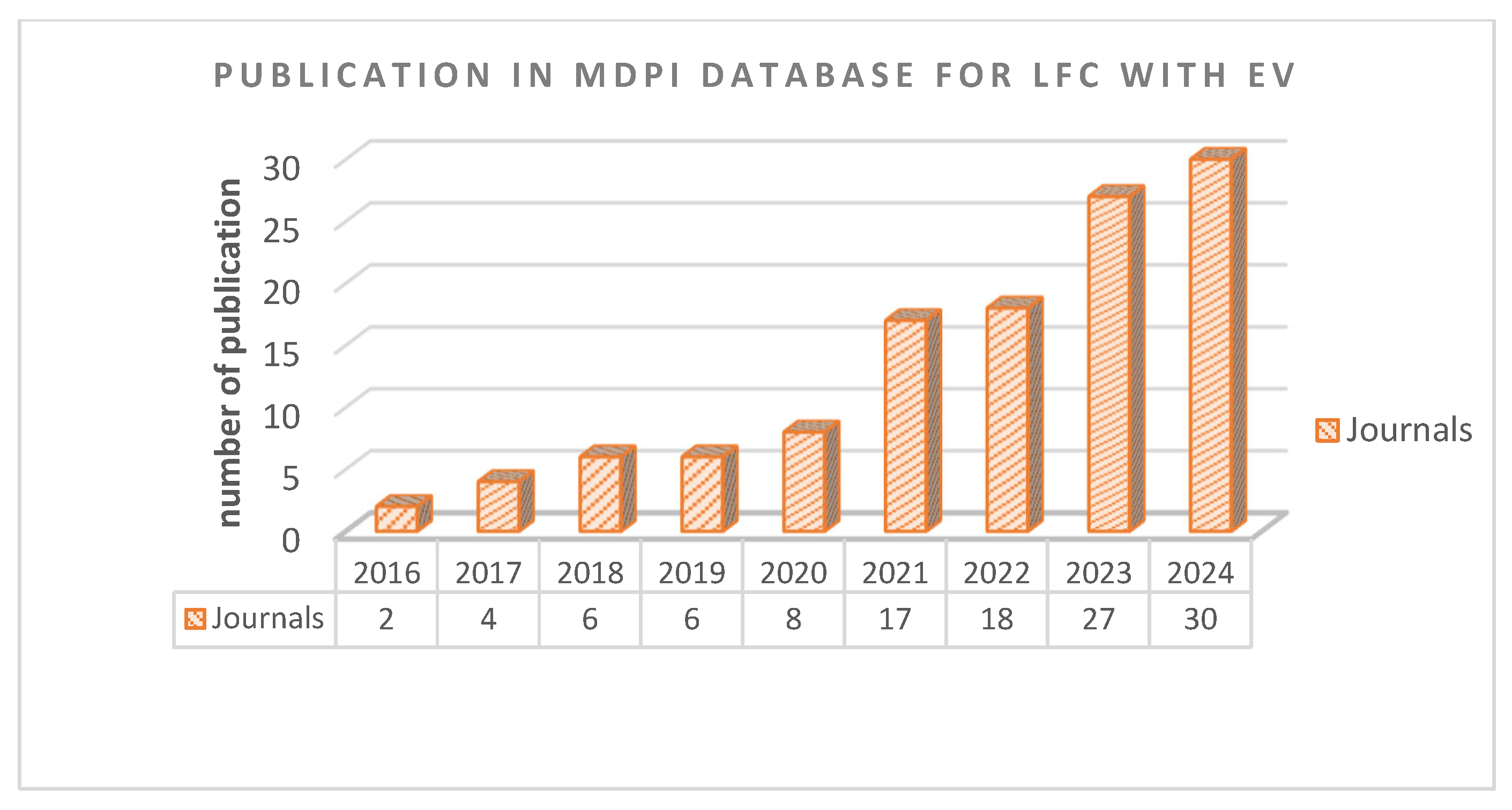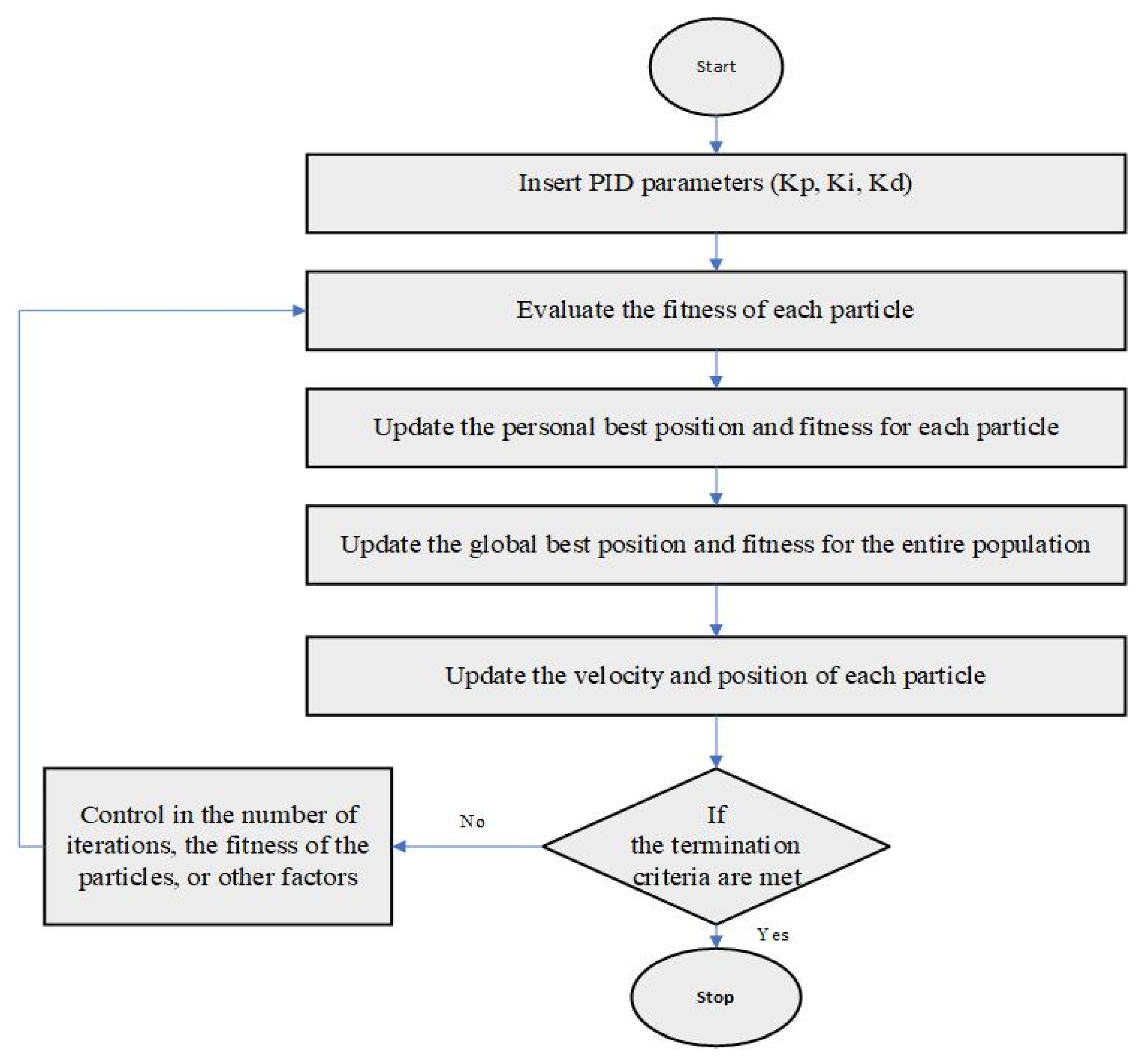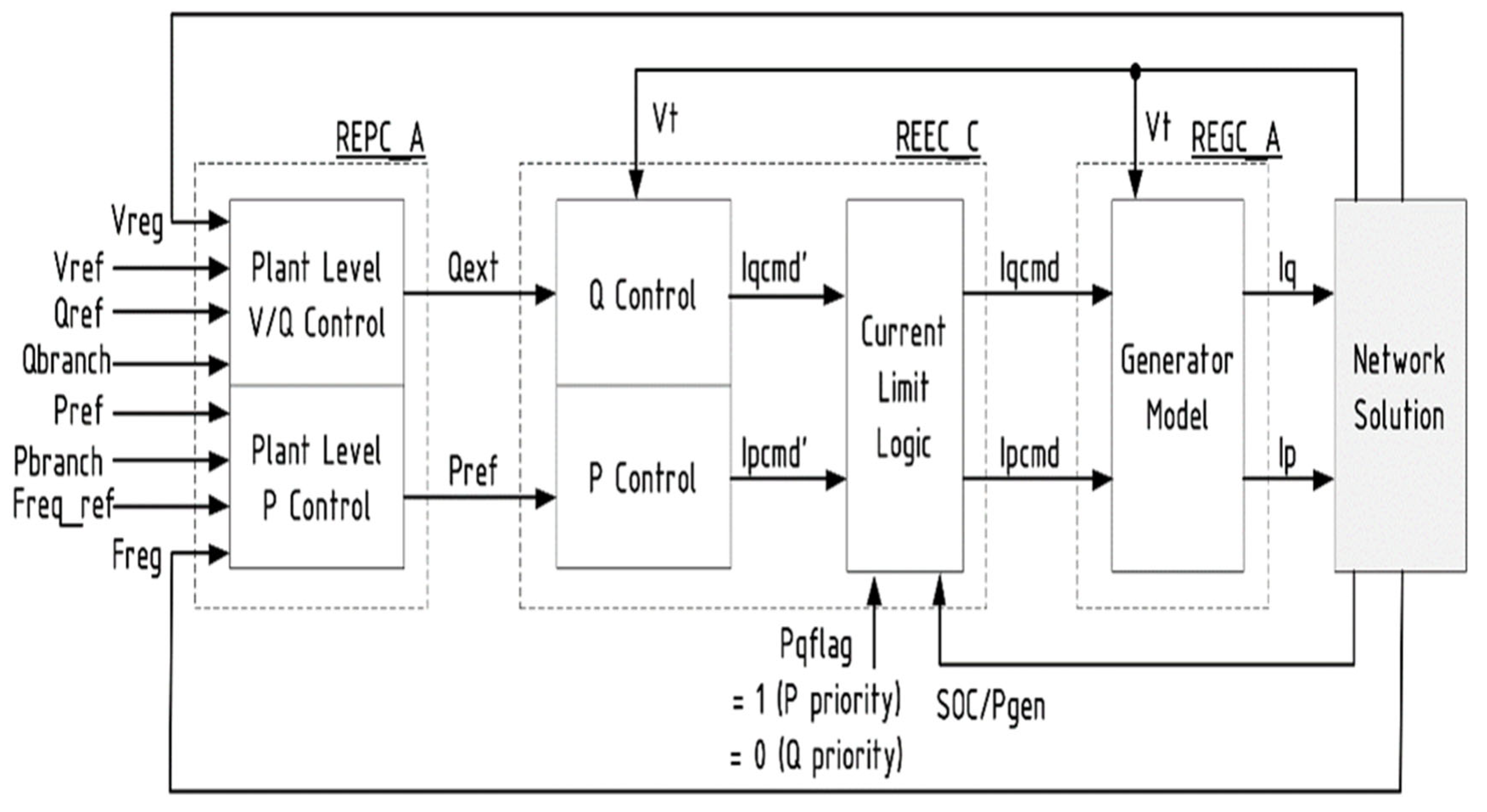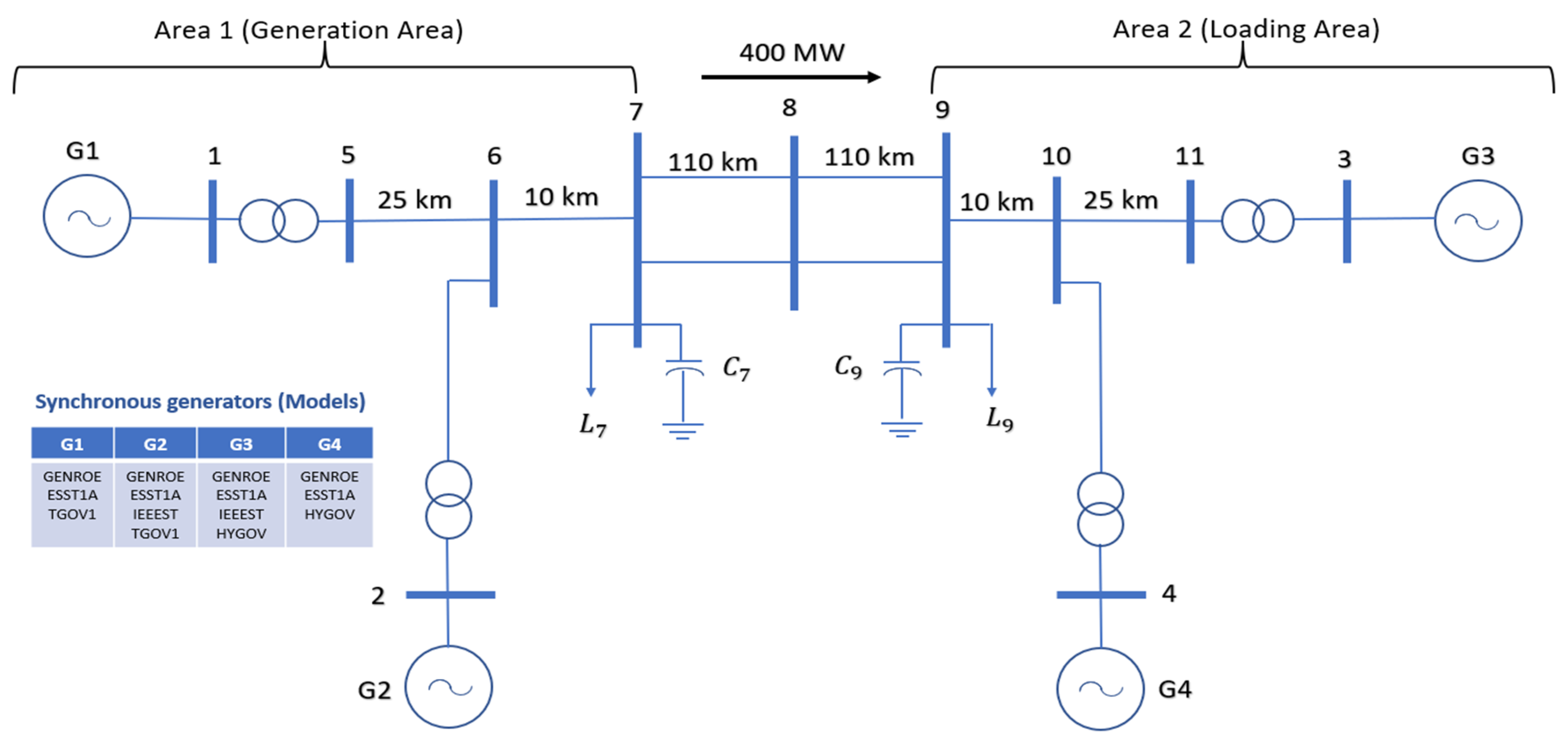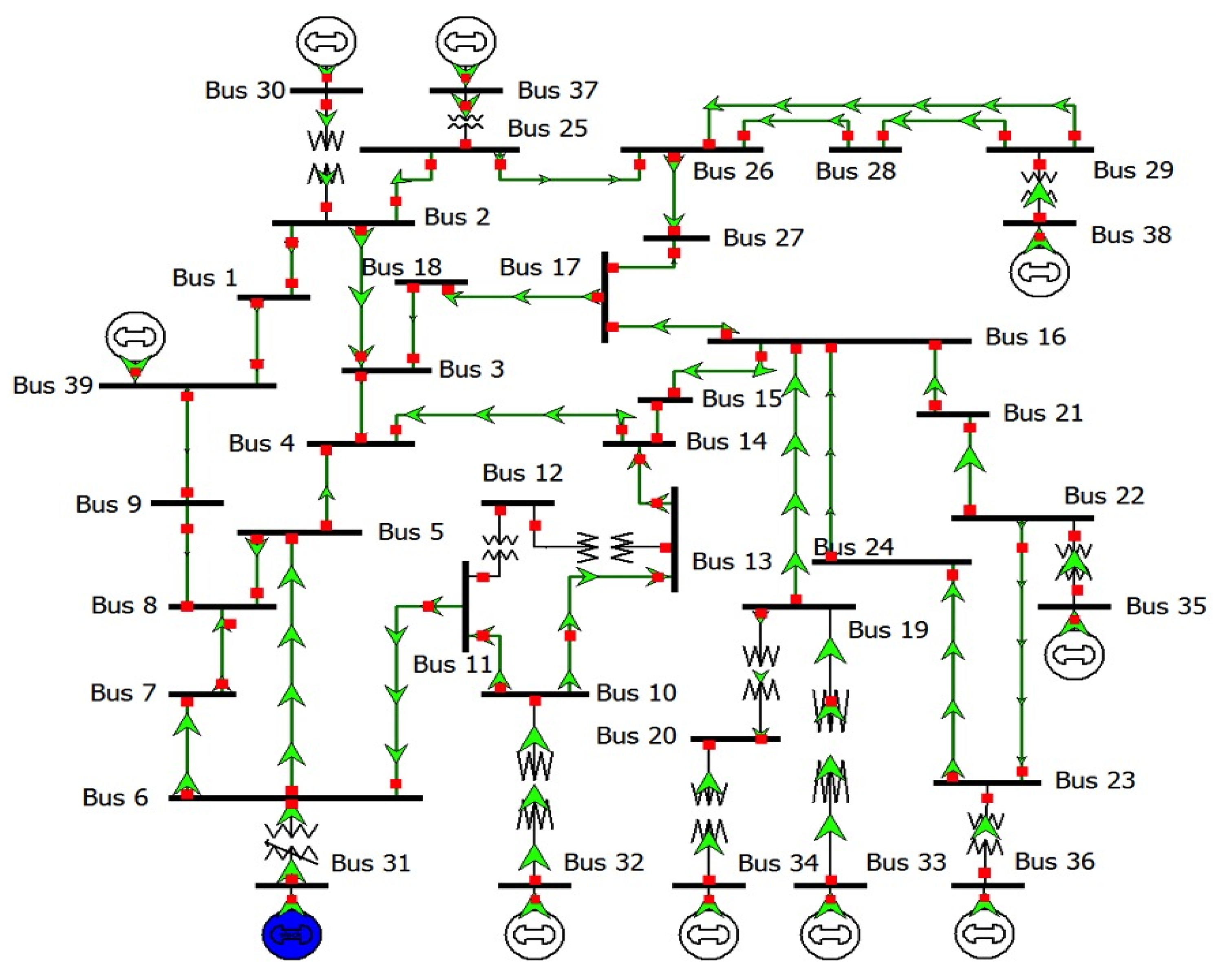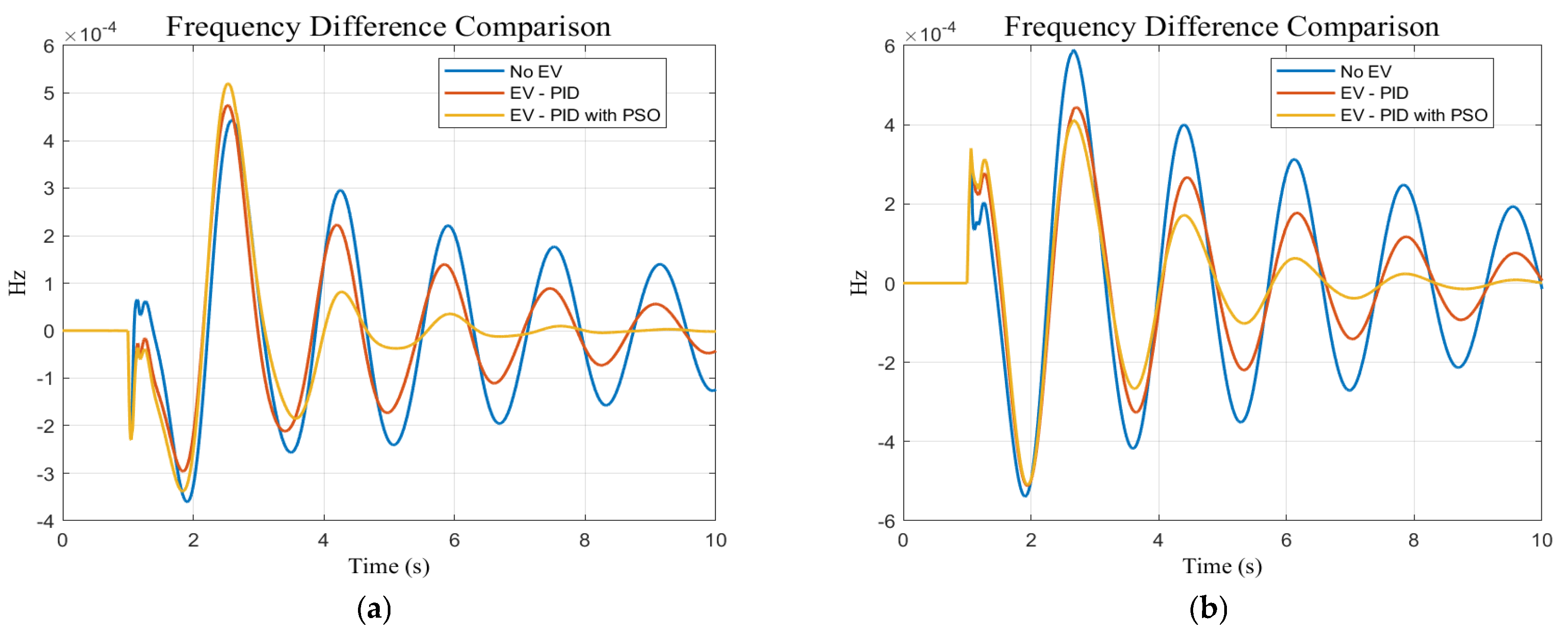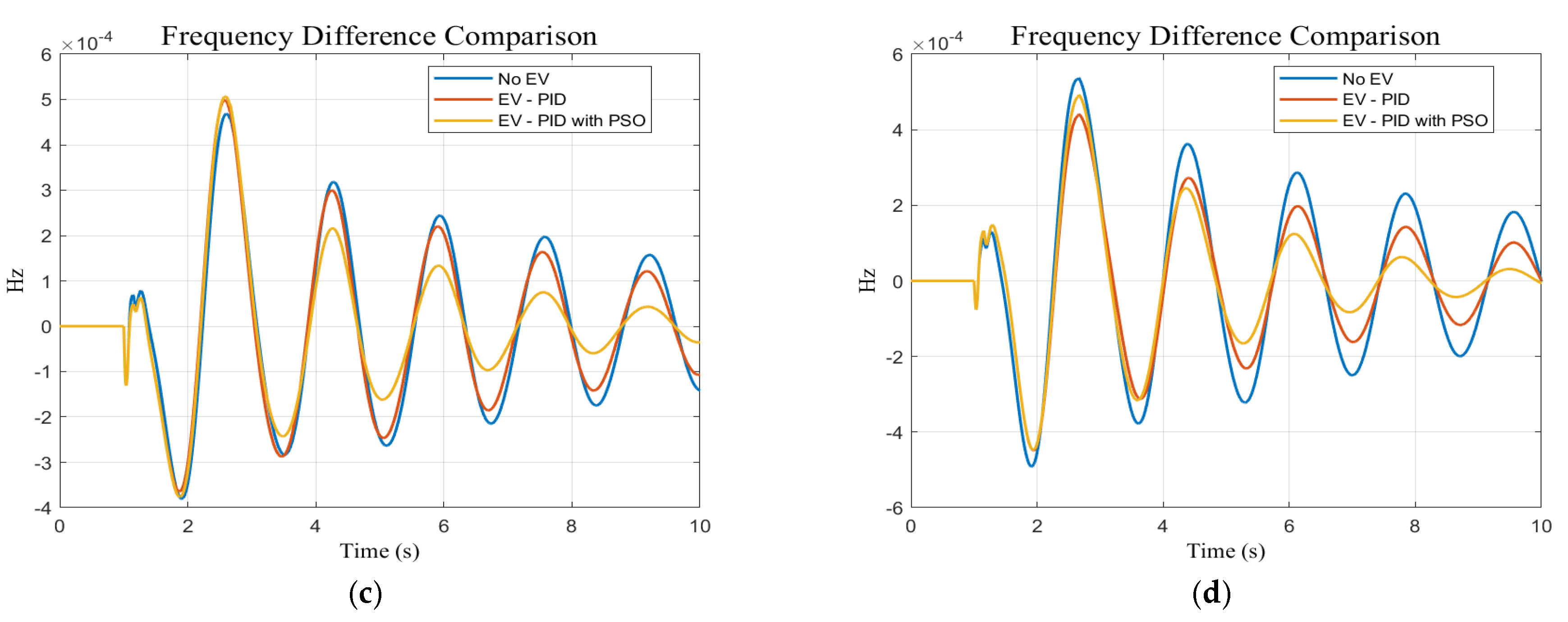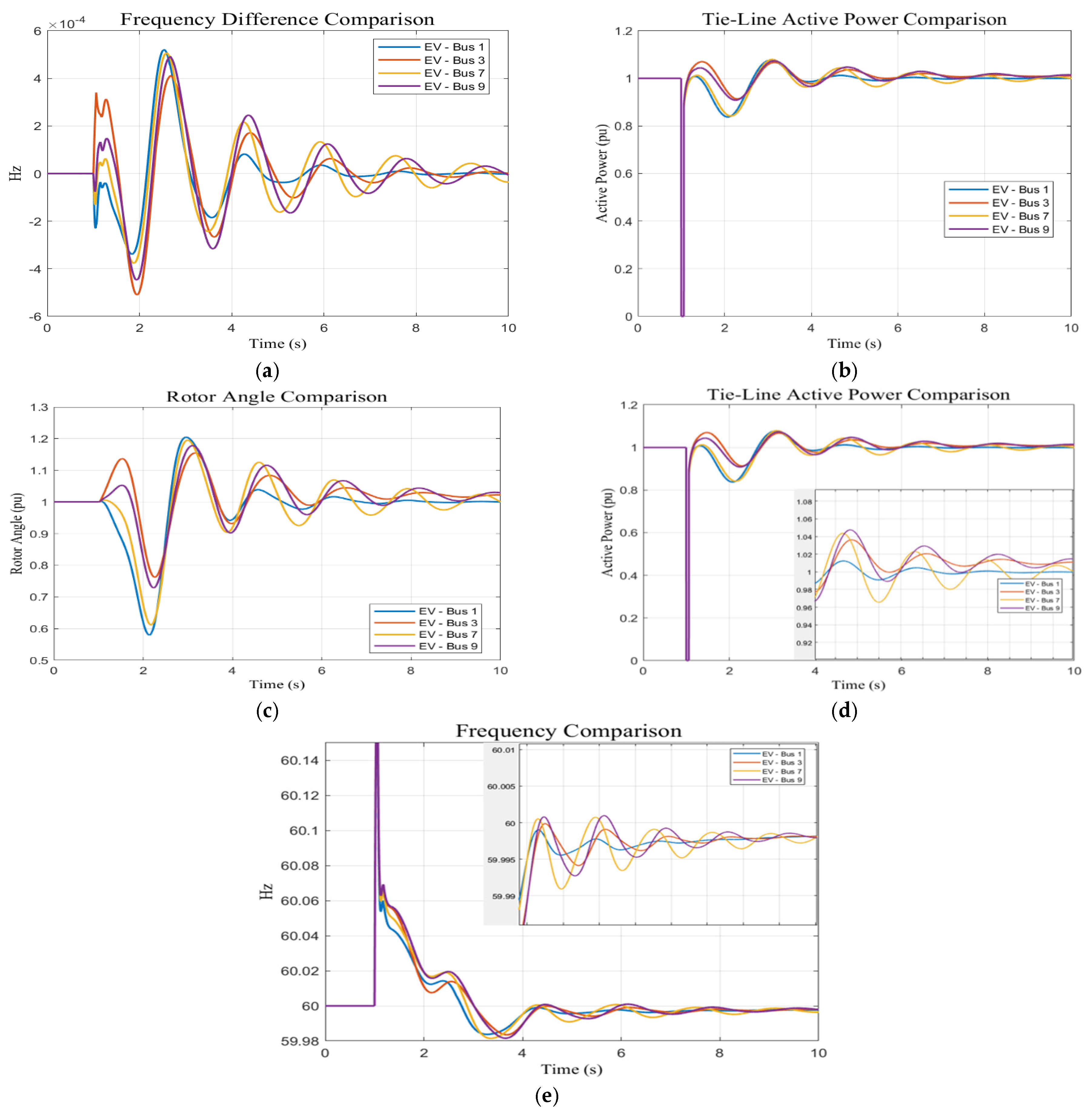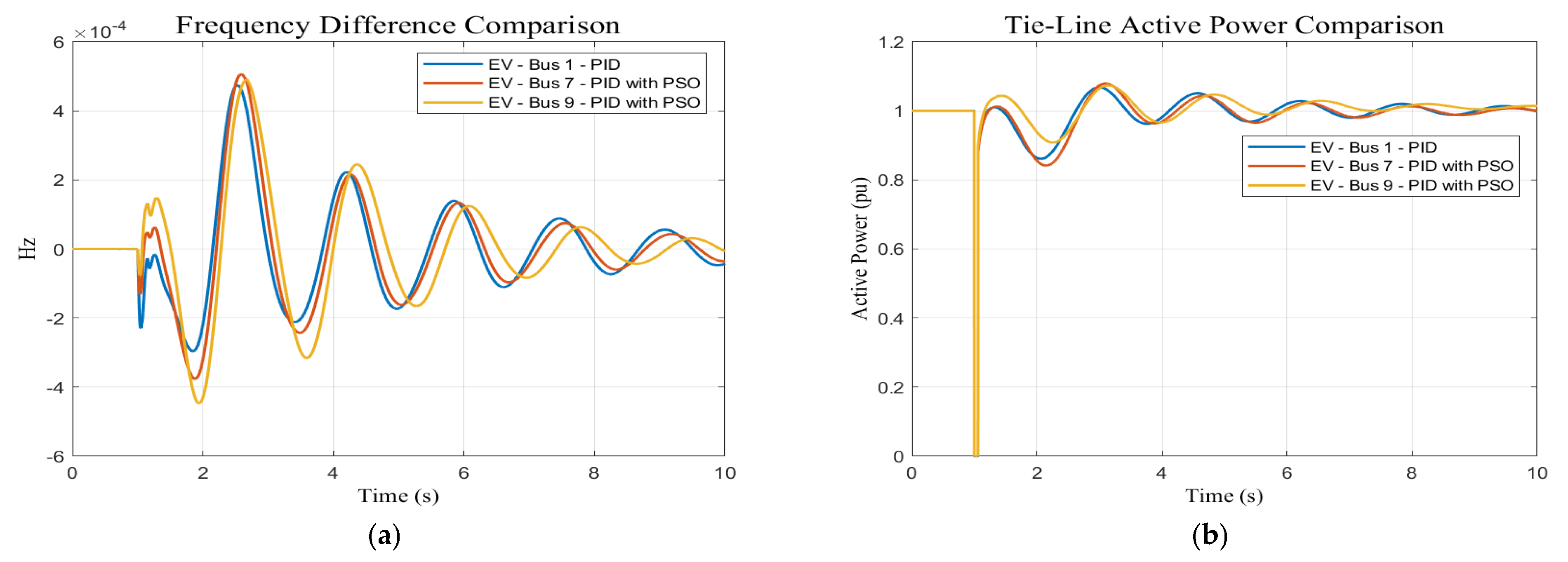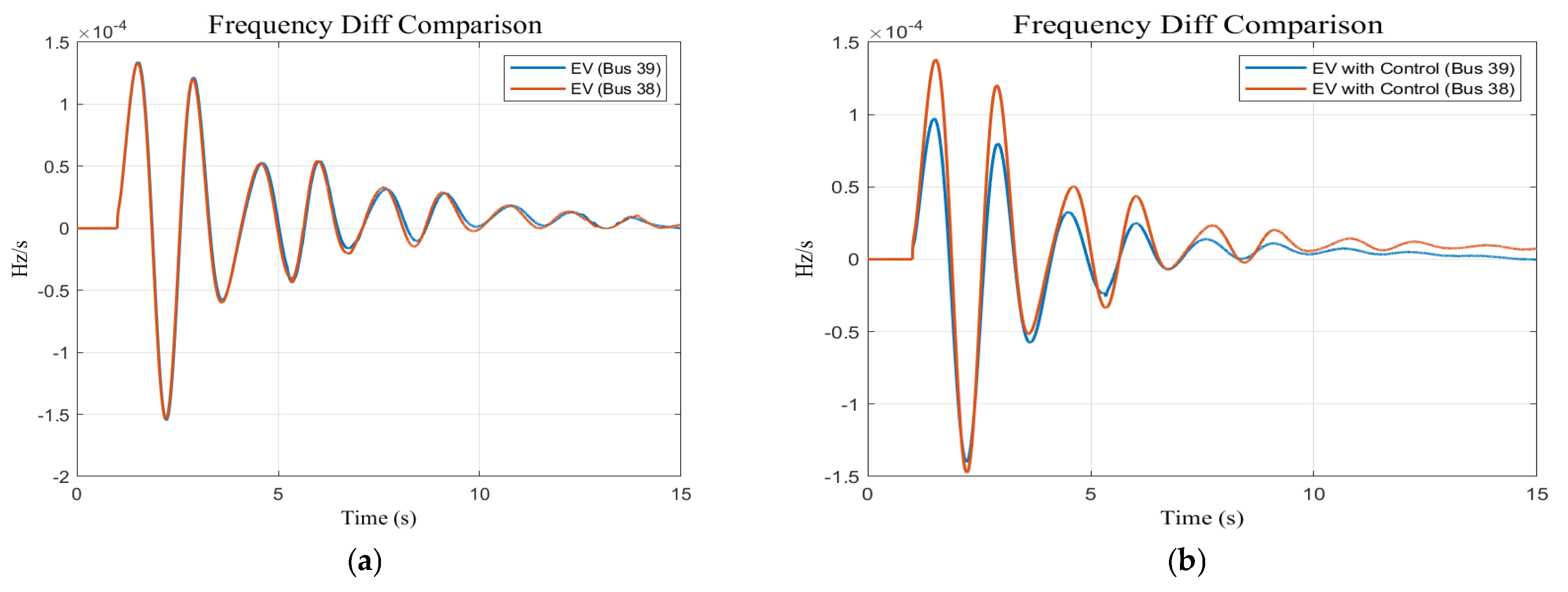1. Introduction
The transportation industry is responsible for around 25% of CO
2 emissions and 55% of the world’s oil consumption. One of the most critical initiatives for directly reducing CO
2 emissions is the development of electric cars or EVs. The energy crisis, environmental problems, such as local air pollution, especially in cities, and global warming [
1,
2,
3] are the primary forces for the development of EVs. One of the concerns surrounding EVs is their power demand and the impact they have on the electricity grid. According to a study by the National Renewable Energy Laboratory (NREL), the average power demand for an EV in the United States, with a driving range of 100 miles, is approximately 3.3 kW. However, the power demand varies based on driving conditions, and it could peak at 30 kW during fast acceleration, hill climbing, or high-speed driving [
4].
EVs require frequent charging, and three primary methods are available: DC Fast Charging, Level 1 Charging, and Level 2 Charging. A regular 120-volt AC outlet is used for Level 1 Charging, which typically charges at a pace of 1 to 5 miles per hour (MPH). It is the slowest charging option and works best when performed overnight. A 240-volt AC outlet is used for Level 2 Charging, typically at a rate of 10 to 20 MPH. A wall-mounted charging unit or a charging station is needed for Level 2 Charging. The charging unit needs to be fitted by a licensed electrician and requires its own electrical circuit. DC Fast Charging uses a high-powered commercial charging station with a typical charging rate up to 55 to 90 MPH. Fast Charging requires a specialized plug, capable of transmitting high power to the EV. Fast Charging is often used for public charging stations, and it is the quickest charging method [
4].
One of the key components of power systems that keeps the balance between power generation and consumption is load frequency control (LFC). Real-time control of the power system’s voltage and frequency is how this is accomplished. LFC greatly influences power systems’ stability and dependability. It contributes to the stable operation of the power system’s frequency and voltage in typical and unusual circumstances. Changes in load demand or system disturbances lead to the power system’s frequency and voltage oscillations. In order to reduce these impacts, numerous LFC methods are utilized [
5]. LFC refers to the regulation of generators’ power output in response to changes in the load demand caused by variations in consumer use. The main goal of LFC is to maintain a balance between power supply and demand, ensuring a stable and reliable power grid with minimal deviations. It is feasible to modify the power output on the grid to satisfy fluctuating demands by regulating the EVs’ discharging rate or stopping the fast charging process. Consequently, the use of EVs in load frequency control (LFC) systems is a possibility [
6]. Electric vehicle fast charging stations (EVFCSs) have the potential to act as an effective Demand Response (DR) mechanism for LFC. EVFCSs can play a vital role in DR for LFC. Charging EV batteries requires a considerable amount of power, and this demand can be managed effectively through DR techniques. EVFCSs can modulate their power output in response to changes in grid frequency and act as a dynamic load that can consume or release energy to the grid by regulating the charging rate of EVs [
7].
The main contributions of this proposed work are
- 1.
Selecting the optimal location of EVFCS as an ancillary service for LFC using Particle Swarm Optimization (PSO) as a first stage;
- 2.
Modeling the dynamic behaviors of EVFCS using the Second-Generation Generic Model (SGGM) in PSSE by modifying the power flow data in the EV station as a negative generation;
- 3.
Modeling an optimal control of the dynamic EVFCS using the PSO method for PID controller’s parameters as a second stage.
2. Related Work
These days, load frequency control is a crucial component of contemporary power systems. It is employed in all sizes of producing facilities, from enormous fossil fuel and nuclear power plants to tiny hydropower plants. It is also utilized in renewable energy systems, including solar and wind power, where output variations can significantly affect the system’s stability. The use of EVs in LFC is being studied and investigated by numerous researchers due to its integration into electrical systems. Recently, many scholarly publications on load frequency control and electric vehicles have been published.
Figure 1 and
Figure 2 show the percentage of the average number of publications on the topic of LFC and EVs from 2016 to 2024, according to the IEEE Xplore site and MDPI database, respectively. Accordingly, this research topic has been one of the significant areas of research over the previous five years.
In [
8], the use of EVs for LFC in restructured power systems has been discussed. This work suggested an enhanced fractional order (FO) controller for robust LFC, taking bilateral transactions into account, and an aggregate model of EV fleets. It selected the best FO controller values in several circumstances using the flower pollination algorithm. The effectiveness of the suggested control approach was confirmed by the simulations that were run. This study offered a chance to develop new grid management goods and services while highlighting the potential of EVs to engage in various ancillary activities in competitive electric markets.
In another study, an adaptive resilient LFC scheme with energy constraints was presented for smart grid subsystems that are subject to denial-of-service (DoS) attacks. This study’s initial section presented a robust triggering communication mechanism in which the uncertainty item brought on by DoS attacks was one of the triggering conditions. In order to lessen the load on communication and thwart denial-of-service attacks, the second section presented an adaptive resilient event-triggering LFC scheme in which the event-triggering parameter can be dynamically changed. Finally, using Lyapunov theory, a stability condition for proportional integral-based LFC systems was determined. Furthermore, case studies based on the various LFC power generation systems—including the one-, two-, and three-area models—were conducted. By comparing the proposed adaptive resilient LFC scheme with resilient event-triggering LFC systems and event-triggering LFC schemes in terms of defense effect and average triggering duration, the simulation results clearly revealed that the suggested adaptive resilient LFC scheme could lower the communication cost while resisting DoS attacks [
9].
In smart grids (SGs), the work in [
10] examined an event-triggered mechanism (ETM) for multiple frequency services of electric vehicles (EVs). A novel SG model featuring multiple EV agents and an ETM was unveiled. To lessen the strain on network capacity, ETM was implemented. EVs were used to reduce frequency oscillations in the system in both primary and secondary frequency services. The integration of SOC control, an ETM variable resulting from ETM control, and a time-varying delay in the state and control input vectors led to the derivation of a mathematical model for the system. Comprehensive SG simulations with three EV agents were conducted to verify the suggested management plan [
10].
In [
11], a hybrid power system was successfully planned as an isolated MG with the use of Vehicle-to-Grid (V2G) and the Tidal Power Unit (TPU). The main LFC controller proposed was a new fractional gradient descent (FGD) based on a single-input interval type-2 fuzzy logic controller (SIT2-FLC), where the LFC performance was improved by carefully adjusting the SIT2-FLC’s footprint of uncertainty (FOU) coefficient. To create the additional control action, a deep deterministic policy gradient (DDPG) with the actor-critic framework was also taken into consideration. Finally, a model-in-the-loop (MiL) simulation was run to evaluate the systemic applicability and viability of the recommended design approach.
An overview of the most recent studies on EV charging stations was provided in another study, which also emphasized some significant problems and difficulties with power architecture design, energy storage methods, microgrid control systems, and energy management optimization. Furthermore, the hierarchical control system, which provides decoupled control objectives in various tiers of microgrid systems for EV charging, is explicitly described. In-depth research was performed on common coordinated control methods and energy management plans intended to maximize the efficiency of EV charging stations [
12,
13].
By providing high virtual inertia and online controlling the charging level, the suggested controller can help inductive electric vehicle (EV) charging systems respond to grid frequency variations in an efficient manner. Utilizing streamlined digital circuits in [
14], a novel IPT multi-power level controller was developed. The suggested multi-power level controller included the virtual inertia control/controller (VIC), which measures the grid frequency and modifies the IPT’s charge level online. As a result, the power transfer from the grid to the EV can be controlled in response to changes in grid frequency by using the suggested VIC IPT charger to manage the switching cycles. Simulated data were given to demonstrate how well the suggested VIC IPT power controller responds to variations in the power grid [
14].
Within the industry, traditional single-loop controllers might not provide stable performance in the event of altered operating conditions [
15]. As an alternative, two-loop cascade fuzzy structured controllers are most effective in nonlinear systems and can demonstrate notably strong performance in dynamic environments. Therefore, taking into account different physical constraints from a practical standpoint, a unique optimal cascade fuzzy-fractional order integral derivative with filter (CF-FOIDF) controller was used for 2-area thermal and hydrothermal PSs. Because of the physical limitations that require an energy storage system, electric vehicle (EV) batteries were used in this study to help power plants quickly arrest oscillations in the system frequency after load demands. The control areas of PSs included a consolidated model of EV fleets. The suggested approach proved to be reliable and effective in providing end customers with consistent, high-quality electrical power [
15].
A sigma-modified adaptive control technique was introduced in a different work to improve the charging profile in an EV charging station with several objectives. For bi-directional EV charging, this algorithm additionally guaranteed a continuous charging profile with controller stability and durability. In order to provide better power quality operation even in the presence of grid distortions, the sigma-mod adaptive controller offered an iterative error convergence at each clock interval of supply voltage dynamics. Through maximum power point operation, a solar photovoltaic (PV) array and battery energy storage work together to support ancillary services and further improve the reliability of EV charging chances. For bi-directional EV charging, multivariable sliding mode control and rule-based phase-shift adaptation at various power transformation stages ensure faster convergence, reduced parameters uncertainty, and controller stability [
16].
A controller known as a Static Synchronous Series Compensator (SSSC) was used to lessen disruptions in networks of interconnected systems. It is a device known as the Flexible AC Transmission System (FACTS), which efficiently lowers transmission line variations to guarantee a steady-state frequency. The objective of this work [
17] was to optimize SSSC parameters within the MATLAB environment by applying the RAT optimization technique, with the goal of reducing frequency variations caused by unknown loads from EV charging stations.
An ideal dispatching control for the EV aggregator was created in a different study. The EV aggregator can give the system regulation capacity with the suggested control scheme while guaranteeing that each individual EV would have adequate SOC. By operating at a faster time- step, the suggested control made it possible for EV aggregators to make better use of EVs. MATLAB and Simulink simulations were run to assess the effectiveness and performance of the suggested dispatching controller [
18].
In [
19], in order to regulate the system frequency in a networked microgrid system, a secondary controller was created and put into use. Energy-storing units (ESUs), synchronous generators, and renewable energy resources (RESs) made up the suggested power system. Photovoltaic (PV) and wind turbine generator (WTG) units were examples of RESs. A battery and a flywheel made up the ESU. The implemented MA-PID controller delivers and is capable of controlling system frequency under a variety of load demand variations and renewable energy sources, according to the results of the validation comparisons.
In [
20], the paper presents an extensive literature review and a critical evaluation of the current state of optimal multi-objective planning for DG installation in the power network, considering various objective functions and their associated constraints. This article examines the implementation of optimization methods for distributed generation planning in radial distribution networks from various power system performance perspectives; it explores the application of various types of DG, distribution models, DG parameters, and mathematical approaches; and it looks at the involvement of different countries in the specified DG positioning and sizing challenge.
From the literature review, the field is still open for study and improvement for electrical vehicle fast charging station location as a dynamic load for frequency control using more accurate optimization methods such as Particle Swarm. Additionally, the use of EVFCSs can produce additional flexibility and stability to the grid by compensation in supply–demand balancing during transit disturbances. The focus of this paper is to investigate the effectiveness of using EVFCSs as a dynamic load for LFC in power systems. This study comprised the optimal location of EVFCSs as a first stage. The output of the first stage will be included in the optimal controller selection to make it the best DR for different network disturbances as the second stage. The Particle Swarm Optimization (PSO) model is utilized to select the best siting of EVFCSs using transient voltage drop and frequency nadir parameters. Optimal control of the dynamic EVFCS load is considered as a second stage in this study using the PSO method as well for the PID controller. The parameters of the PID controller are obtained to effectively aid power system stability during disturbances. The proposed model is applied to the Kundur Power System and IEEE 39 bus system for three types of system disturbances: generation reduction, load reduction, and line faults.
3. Optimal Siting of EVFCS Model Using Particle Swarm Optimization Model
The complex nonlinear optimization problem has a known solution. They came up with the idea of using a particle swarm to optimize functions [
21]. We assume an n-dimensional function’s global maximum, which is defined as Equations (1) and (2) (see
Figure 3):
where
and
represent the given function variables set.
A swarm of particles is maintained via the Particle Swarm Optimization (PSO) algorithm, a multi-agent parallel search method. Each particle in the swarm represents a potential solution. Every particle travels through a multidimensional search space, modifying its position based on its own experiences as well as those of its neighbors. Assuming that
represents the position vector of particle (
i) in the multidimensional search space at a given time step (
t), each particle’s position in the search space is updated by the following equation:
where
is the particle’s velocity vector, which propels the optimization process and represents each particle’s collective experience knowledge as well as its own experience knowledge, and
is the uniform distribution with respect to its minimum and maximum values.
As a result, in a PSO approach, every particle is started at random and assessed to determine fitness as well as the global best (the best value of every particle in the swarm) and personal best (the best value of every particle). Following that, a loop begins to identify the best answer. The loop updates each particle’s position based on its current velocity after updating each particle’s velocity first using the personal and global bests [
22].
In our proposed siting model, the transient stability parameters in terms of voltage drop and rate of change of frequency (ROCOF) are considered. We modeled the problem as optimal power flow with objective function minimizing the voltage drop (
) and the rate of change of frequency (ROCOF) after a disturbance:
where
Vi+ and
are the voltage at bus (
i) after a system disturbance and before a disturbance resulting from power flow analysis, respectively.
where
f0 is the nominal frequency and
H is the equivalent system inertia that can be calculated using Equations (6) and (7):
where
J is the total momentum of inertia of the system in (kgm
2) and
S is the rated power in (MVA) of the system synchronous generators.
In order to have one multi-objective function for optimal power flow, Equations (4) and (5) have been normalized through being divided by the maximum voltage drop in Equation (4), and the maximum rate of change of frequency can be acceptable in Equation (5). In our proposed work, both voltage drop and ROCOF have the same weights; however, this can be updated by using different weights of
w1,
w2; Equation (8).
The generation–load balance constraint will be used to choose the impact of adding EVFCS in that bus after disturbance, as follows:
where
PGi+ and
PLoadi+ are the generator output power and the load power required at bus (
i) after a system disturbance, respectively.
Xi is a flag variable taking “1” if EVFCS is installed at bus (
i) and “0” otherwise.
PEV is EVFCS power rating in KW.
For selecting only one place for installing EVFCS, the following constraint has to be added:
The bus that has the value Xi equal to “1” is the best location for installing EVFCS with a minimum value of ΔV and ROCOF.
Accordingly, the optimal PID controller design using Particle Swarm Optimization model is described in the following section.
5. Experimental Setup and Results
The experimental setup starts with running the well-known OPF with minimum fuel cost. The output of OPF will be input for PSSE simulation that is used to study different disturbances: generation reduction, load reduction, and line faults. Δ
Vmax and
ROCOFmax are the two outputs of PSSE. After that, we applied our proposed method (Stage 1) to select the optimal location of EVFCS. In this step, the OPF objective function is changed to be similar to Equation (8) with the consideration of w
1 equals w
2. The OPF will call PSSE in each iteration to measure the current transient voltage drop ΔV and the current transient rate of change of frequency
ROCOF during disturbances if EVFCS is installed in the bus (
i). The proposed PSO is applied with the proposed dynamic modeling of EVFCS using PSSE to select the best EVFCS location as a result of Stage 1. After this stage, the location of EVFCS is kept fixed, and the second stage is applied. The second stage uses PSO to select the best PID parameters that reduce transient voltage drop Δ
V and transient rate of change of frequency ROCOF, similar to the procedures in
Figure 4. Finally, the results of Stage 2 reveal the best
KP,
KI, and
KD parameters for the PID controller installed in EVFCS at the best location obtained from Stage 1.
5.1. Simulated Network
Figure 6 and
Figure 7 show Kundur’s model and the IEEE 39 bus system. In Kundur’s model under typical working conditions, electricity flows from area 1 to area 2, and the network has four machines (G1 and G2 belong to area 1, G3 and G4 belong to area 2), with an overall generation capacity of 2819 MW. The network is designed with several buses and transmission lines connecting the loads to generators. The two areas are interconnected through a series of transmission lines with specific distances between buses: 25 km between Bus 1 and Bus 5, 10 km between Bus 5 and Bus 6, 110 km between Bus 6 and Bus 7, another 110 km between Bus 7 and Bus 8, and a further 110 km between Bus 8 and Bus 9. From Bus 9 to Bus 10, the distance is 10 km, followed by 25 km from Bus 10 to Bus 11 (
Figure 6).
In addition, the network includes reactive power elements at load area buses to manage voltage levels and stability. Capacitor C7 with a capacity of 200 MVAr and Load L7 with a capacity of 967 MW are present at Bus 7, while Capacitor C9 with a capacity of 350 MVAr and Load L9 with a capacity of 1767 MW are at Bus 9. The total active power of Kundur’s system is 2734 M. There is a power flow of 400 MW from area 1 to area 2, indicating the amount of transfer of power through the interconnection. This model is typically used to analyze the power flow, stability, and reliability of the interconnected power system.
In order to apply the proposed location model to a larger transmission network, the IEEE 39 test system was selected. It has 10 generator machines, 46 branches, and 19 loads. The overall generation capacity of the system is 6298 MW, where the total load connected is 6097 MW (
Figure 7).
5.2. Case Studies
To evaluate the performance of the methodology proposed in this study, simulations were conducted using the PSSE software (version 36) for Kundur’s system as a case study, as seen in
Figure 6. The PSSE model used in the simulations was obtained from the Illinois Center for a Smarter Electric Grid (ICSEG) at the University of Illinois at Urbana-Champaign; PSSE models. To analyze the simulation results and assess the effectiveness of using PID control with EV stations, and examine the simulation findings, an assessment was carried out with a focus on four specific buses in Kundur’s system. These buses (1, 3, 7, and 9) were chosen based on an observability analysis that means two points should be in the generation area and two points in the loading area. Hence, at least four buses are required to observe the dynamic response of the system stability in two areas. However, the IEEE 39 bus test system requires only two buses (38 and 39) since the interconnection of the system makes it considered as one area that includes generation and load. Three different disturbances are considered in this study: generation reduction (50 MW, 100 MW), load reduction (50 MW, 100 MW), and a line fault. Since there are lines between Bus 7, Bus 8, and Bus 9 connecting the two areas in Kundur’s system, the system response during a bus fault at Bus 8 was analyzed. However, the heavy line that connects Bus 19 and Bus 16 was selected for line fault in the IEEE 39 bus test system.
Table 1 shows the power flow analysis of IEEE 39 before installing the EV charging stations.
The EV station size is chosen to be equal to 1% of the system generation that is around 30 MW and 65 MW in Kundur’s system and the IEEE 39 bus test system, respectively.
5.3. PSO Location Results of Optimal EV Station Location
The PSO location model was applied to Kundur’s system to evaluate the optimal locations of EVFCSs that minimize both transient voltage drop and frequency nadir parameters during generation reduction, load reduction and line fault disturbances. The PSO location model ranks the system buses from 1 to 11, where 1 is the best location and 11 is the worst location for EVFCS as DR for LFC.
Table 2 shows the result of the PSO location model for Kundur’s system where Bus 1 then Bus 4 were the optimal locations with weights of 0.3332 and 0.4296, respectively. Bus 1 is the optimal location in the generation area, and Bus 4 is the optimal location in the load area. The worst places for installing EVFCS from the LFC point of view are Bus 8, Bus 7, and Bus 6 since these buses connect the generation area with the tie line.
For the IEEE 39 bus test system, the PSO location model was applied, and the result of optimal EVFCS locations as DR for LFC is shown in
Table 3.
Bus 39 then Bus 1 were the optimal locations for EVFCSs as DR for LFC with PSO weights of 0.008307 and 0.020505, respectively. Since more power was flowing to buses near Bus 39 and Bus 1, these buses are more suitable for LFC, as the PSO location model showed in its result.
To validate the result of the best spot to install EVFCSs as DR for LFC, a sensitivity analysis is carried out. In this analysis, every potential location in Kundur’s system for the EV station is evaluated, and the optimum options are shown. The EV station is first located on a particular bus as part of the investigation procedure. The system, which is referred to as a Single-Input Single-Output (SISO) system, is then represented by a transfer function that is created. The ideal observation position provides the system’s output, and the active power reference of the EV station serves as its input. Equation (15) describes the power system’s identification with respect to the placement bus signals [
35]:
The eigenvalues of the system are denoted by
, while the system residue, represented by
, is a measure of the interaction between mode observability and controllability. When
is unobservable or uncontrollable,
. In complex power systems, various equipment is typically associated with one or more modes within the system. Among these modes, inter-area oscillation modes are particularly noteworthy. They can be effectively observed through the controlled system
when there is a stronger level of mode observability and controllability compared to other modes [
36]. These inter-area oscillation modes carry significant importance in the overall dynamics and stability analysis of complex power systems. The residues provide valuable insights into the effectiveness of control strategies and the ability to observe oscillation modes within the power system. By evaluating the residues, researchers can assess and validate the controllability and observability characteristics of different modes, allowing for the identification of critical modes that require attention and damping measures [
37,
38].
Table 4 presents the residue analysis of when the EV station is placed at each bus for Kundur’s system. It can be concluded that generation area buses have a higher residue magnitude, which means higher controllability. For example, among the generation area buses, the center of the generation (Bus 1) is the best placement of the EV, and the loading center of generation area (Bus 7) is the worst placement.
This sensitivity analysis validates the outcomes from the PSO location model from a controllability and observability perspective.
5.4. PSO—PID Model Results
A typical PID controller and a base case scenario with no control input for each EV station placement bus were compared in the first comparison to examine the performance of utilizing a PID controller with the PSO model for EV stations. The frequency difference response comparison for the chosen four buses, Buses 1, 3, 7, and 9, with the EV station installed is shown in
Figure 8a–d. The findings unequivocally show that in comparison to the other scenarios, the PID controller with PSO greatly enhances the dominant oscillation mode’s damping.
Secondly, the performance results of the PID controller with PSO for different EV station placement buses are presented in
Figure 9.
Figure 9 shows the frequency response, frequency difference, active power tie line, and rotor angle for each case. The analysis shows that by placing the EV station at Bus 1, the generation center of the generation area, it has the highest impact on enhancing system stability. On the other hand, Bus 7, the loading center of the generation area, has a relatively smaller impact. Lastly, Bus 9, the loading center of the loading area, has the least influence on system stability. In order to assess the power of optimizing PID parameters using the PSO-PID model, a comparison between the best bus placement with traditional PID and the worst bus placement with PID-PSO is presented in
Figure 10 and
Figure 11. It shows that Bus 1 of Kundur’s system and Bus 39 then Bus 1 in the IEEE 39 bus system are the best locations for dynamic EVFCSs (
Table 2 and
Table 3).
6. Discussion
According to this study, the best way to improve the system stability of Kundur’s system is to locate the EV station at Bus 1, which is the generation center of the generation area. After that, Bus 4, the loading area’s generation center, shows a favorable influence, but Bus 7, the generation area’s loading center, has comparatively less impact. Finally, the loading center of the loading area, Bus 9, has the least impact on the stability of the system. The results demonstrated that the PID controller with PSO significantly increases the dominant oscillation mode’s damping when compared to the other cases. Generally, Bus 1 then Bus 4 of Kundur’s system and Bus 39 then Bus 1 in the IEEE 39 bus system are the best locations for dynamic EVFCSs. If the EVFCS is located in least bus controllability and observability, the PID parameters have to be optimized in order to enhance their capability using the PSO-PID model.
To validate our main findings of the proposed work, we compare the stability performance of the results of Kundur’s system with the methods in [
39]. Three controlling methods were highlighted in [
39]: nonlinear disturbance observer (NDO), nonlinear disturbance observer based on adaptive super twisting sliding mode control (ST-SMC), and PI-PSO with conventional control as well as our proposed PID-PSO. The comparison between these methods based on frequency deviation (Δf) is shown in
Table 5.
It is clear from the above comparison that adding an EV charging station as a dynamic load for LFC enhances stability performance in terms of frequency deviation. EV-PID control overcame the performance of PI-PSO due to the capability of being dynamic when modeling EV station in this proposed work. When using PID-PSO with EV stations as dynamic load, the deferential covers the previous events, the integration covers the future events, and the proportional covers the amplitude needed. Hence, this proposed technique is the most suitable for the purpose of a dynamic load as LFC.

